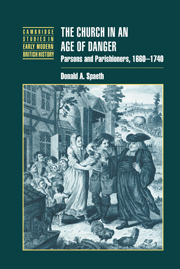Book contents
- Frontmatter
- Contents
- List of tables
- Acknowledgements
- List of abbreviations
- 1 Introduction
- 2 Clerical profiles
- 3 Arenas for conflict
- 4 The management of disputes
- 5 Pastoral care
- 6 Tithes and religious conflict
- 7 The nonconformist threat
- 8 Popular observance
- 9 Matters of life and death
- 10 Singing and religious revival
- 11 Conclusion
- Selected bibliography
- Index
- Cambridge Studies in Early Modern British History
6 - Tithes and religious conflict
Published online by Cambridge University Press: 28 July 2009
- Frontmatter
- Contents
- List of tables
- Acknowledgements
- List of abbreviations
- 1 Introduction
- 2 Clerical profiles
- 3 Arenas for conflict
- 4 The management of disputes
- 5 Pastoral care
- 6 Tithes and religious conflict
- 7 The nonconformist threat
- 8 Popular observance
- 9 Matters of life and death
- 10 Singing and religious revival
- 11 Conclusion
- Selected bibliography
- Index
- Cambridge Studies in Early Modern British History
Summary
The payment of tithes was the issue over which parsons and parishioners quarrelled most often in the century after the Restoration. Tithes were not a new source of disagreement. Disputes over tithes had revealed lay–clerical tensions on the eve of the Reformation. An increase in the number of tithe suits, it has been argued, was one consequence of the clergy's loss of prestige after the Reformation. The two thousand clerical tithe cases recorded in Lichfield diocese in the first half of the seventeenth century increased the laity's identification of the parish clergy with the unpopular consistory courts. Christopher Hill argues that difficulties in collecting tithes contributed to the economic problems of the Church on the eve of the Civil Wars. The Restoration did not resolve these economic problems, and tithes remained a major grievance in the late eighteenth and early nineteenth centuries, when they are credited with contributing to anticlericalism, declining Church influence, and the weakening of the alliance between church and state. Although relatively few people refused to pay tithes for reasons of religious principle, disputes over payment nevertheless had considerable significance for lay–clerical relations and for religion more generally. Their collection had the potential to poison relations between the clergy and the laity. Clerical dependence upon tithes for much of their income made it difficult for them to heed Bishop Burnet's advice that they keep their responsibility for the souls of their parishioners more in mind ‘than so many scores of pounds, as the living amounts to’. Impoverished clergymen had little choice but to seize any opportunity to maximise their incomes, even if this was at the expense of their congregations.
- Type
- Chapter
- Information
- The Church in an Age of DangerParsons and Parishioners, 1660–1740, pp. 133 - 154Publisher: Cambridge University PressPrint publication year: 2000

